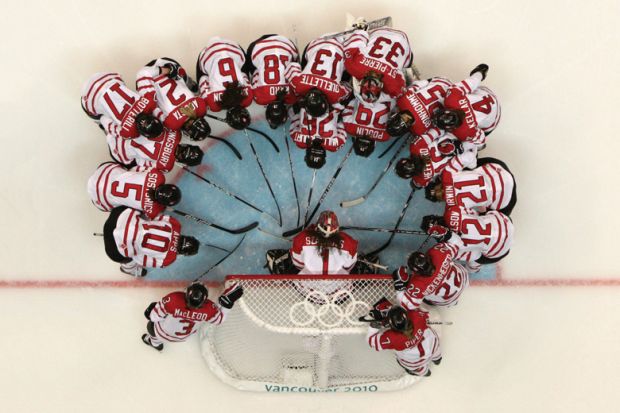As a Briton living in Canada for the past 15 years, I was delighted to take on this book for review. Ice hockey – just “hockey” to Canadians – is the national game. Actually, it’s much more than that; it permeates the national character. It’s part of the folklore. Canadians still speak in hushed tones, and wipe back a tear, when reminiscing about the heart-stopping drama of the 1972 series against the Russians. If you need a comparison, think of England’s 1966 football World Cup, with captain Phil Esposito as the Canuck Nobby Stiles.
In a nice touch, Université de Moncton physicist Alain Haché’s look at the scientific principles behind the game is divided into three periods, just like the game itself. There are chapters on the science of ice, skating and shooting, all served up clearly and readably, with no equations needed. Chapters follow on statistical analysis, what makes a great player and a successful team, and the importance of the goalie. Sports injuries are mentioned, although I would argue that more should have been said about protection from head injuries. There is even a little discussion of the more unsavoury side of the game – namely the fighting and violence. To a non-Canadian, the casual acceptance of fighting by players is disconcerting, and detracts from the attractiveness of the sport. To be honest, if I want to see men hit each other with sticks, I can watch Morris dancing. In my eyes, the prohibition of certain body-checking moves in women’s hockey makes for a slightly less physical, but much more fluid, skilful and attractive game.
This brings me to a major criticism. Although the writing makes it suitable for a wide audience, Slap Shot Science is all about the men’s game and the National Hockey League. The women’s game is referred to on page ix of the preface – and that’s it. The Canadian women’s hockey team (pictured above) has won four consecutive gold medals at the Winter Olympics. Surely they rate a mention? This is a bad move for equality, and also a strange publishing decision. Why alienate a large portion of your potential readership?
The greater let-down, though, is the production. The cover is a nondescript dark green with light green lettering. The picture on the front has a hockey player in white and blue, and it just doesn’t look right. The illustrations inside are all monochrome. The line drawings are nice and clear, but the photos are lacklustre. And then there are the graphs! They look as if they have been lifted out of everyone’s favourite excellent spreadsheet. (You know the one I mean.) Even worse, some of them have straight lines interpolated on the data, when the data clearly aren’t – a big scientific no-no. What this text is crying out for is lots of colour photographs and diagrams so that reading it becomes a real treat. It needs to be bold and eye-catching. Haché’s work really does deserve that treatment, because he writes well, clearly and with great enthusiasm for the subject. Although I recommend Slap Shot Science highly as a great read, it could have been much more.
Andrew Robinson is a contract instructor in physics, Carleton University, Ottawa.
Slap Shot Science: A Curious Fan’s Guide to Hockey
By Alain Haché
Johns Hopkins University Press, 192pp, £18.50
ISBN 9781421417929
Published 27 November 2015
POSTSCRIPT:
Print headline: Thrills, chills and spills
Register to continue
Why register?
- Registration is free and only takes a moment
- Once registered, you can read 3 articles a month
- Sign up for our newsletter
Subscribe
Or subscribe for unlimited access to:
- Unlimited access to news, views, insights & reviews
- Digital editions
- Digital access to THE’s university and college rankings analysis
Already registered or a current subscriber?




